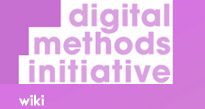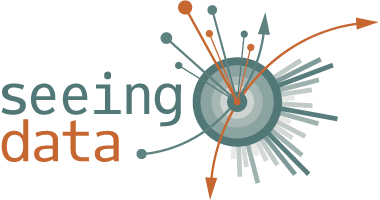Keynote at the Digital Methods Initiative (DMI) Summer School, University of Amsterdam, 23rd June 2014

I recently gave a keynote speech and set a project brief about the Seeing Data project at the Digital Methods Initiative (DMI) Summer School in Amsterdam.
The DMI has been ‘re-working method for Internet research’ since 2007, but its foundations stretch back beyond that, to the publication in 2000 of the collection of essays Preferred Placement, edited by Richard Rogers, DMI director. According to the book’s cover, Preferred Placement went ‘backstage’, asking how search engines, portals, settings, filters and recommendation systems were shaping the web surfing experience, in order to understand the new knowledge politics of the web. Rogers and other DMI folk have been doing these things ever since, pioneering what are now known as ‘digital methods’: that is, digitally native methods for understanding digitally native media.
Every year the DMI runs summer and winter schools, to learn and develop techniques for answering social and cultural research questions with digital methods. The schools assemble an impressive combination of scholars, designers, technical folk and NGO and charity workers, all keen to know more about how digital methods might help them in their work. This year was no exception, and amongst attendees were several folk from the Density Design research lab in Milan, which specialises in ‘the visual representation of complex social, organizational and urban phenomena’.
My keynote talk provided a general introduction to our Seeing Data project and to some of the questions that attendees will need to address as they seek to represent their data visually. These include questions about how viewers of their visual representations might respond to them and the factors that might influence responses, such as: contexts of consumption, processes of visual perception, purpose of visualisation, extent of visualisation literacy, subject interest and other subjective and non-subjective factors. In the talk I also suggested that summer school attendees might think about how aspects of the production process might shape how visualisations get received – how they, the participants, imagine their data, how they ‘clean’ it, the size of their data set, and decision they make about design style, colour, chart type and format, degree of annotation, what values they want to communicate, whether they want people to ‘read’ or ‘feel’ their data. A lot to think about in a short space of time!
I also set a brief for attendees at the summer school. We provided them with the URLs of 50 visualisations which have ‘trended’ in recent years, and asked them to trace how these had been shared, by whom, using what language. We encouraged them to think about whether we could conclude anything about ordinary engagements with and conversations about visualisation from this analysis. We also gave them a couple of other options – to analyse a dataset of 5000 tweets gathered according to specific visualisation hashtags, again to look at language use, or to explore how platforms like Pinterest might be used to share and talk about visualisations. You can access the full brief by clicking on the link below. Watch this blog to find out what was uncovered!
Further reading
Introduction to The Digital Methods Initiative: https://wiki.digitalmethods.net/Dmi/MoreIntro
Rogers, R (ed) (2000) Preferred Placement, Jan Van Dyck Academy
Rogers, R (2013) Digital Methods, MIT Press
